Example Projects
Portable LAN Cable Test Instrument
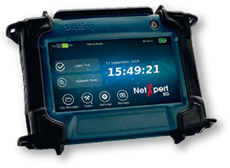 Omniware assisted Softing developers with the implementation of an Intel Arria 10 FPGA based cable
application qualifier for both copper and fiber. Omniware implemented several VHDL modules for accessing Intel
networking IP including, MAC, PHY, 1G/10G and 10GBASE-R IP. Additionally, a UIO driver was developed for
accessing real-time full speed packet capture into a dedicated DDR4 memory in addition to a PCIe interface
for an M.2 Wi-Fi module. Also, a packet generator and monitor was developed for bit error rate testing and
cable length measurement.
Omniware assisted Softing developers with the implementation of an Intel Arria 10 FPGA based cable
application qualifier for both copper and fiber. Omniware implemented several VHDL modules for accessing Intel
networking IP including, MAC, PHY, 1G/10G and 10GBASE-R IP. Additionally, a UIO driver was developed for
accessing real-time full speed packet capture into a dedicated DDR4 memory in addition to a PCIe interface
for an M.2 Wi-Fi module. Also, a packet generator and monitor was developed for bit error rate testing and
cable length measurement.
Flight Computer and Rocket Motor Avionics
 Omniware worked closely with engineers in avionics, propulsion and GNC
(guidance, navigation and control) groups at Virgin Orbit
to develop multiple FPGA modules for first
and second stage engine controllers and flight computers. Omniware implemented a VHDL design for the
first and second stage rocket’s telemetry acquisition and transmitter using an Intel Cyclone V FPGA,
including a PCIe interface to a Linux based
flight computer. Intel’s Platform Designer design flow was used to implement all telemetry avionics
modules including variable rate transmitter, Honeywell Inertial Measurement Unit (IMU) with an SDLC (synchronous data link control) protocol, power supply and board telemetry, acquisition time stamping and an
Ethernet MDIO serial management interface. An MFC based windows application was developed for module testing
and debug, including the PCIe driver interface to Jungo’s WinDriver kernel module.
Omniware worked closely with engineers in avionics, propulsion and GNC
(guidance, navigation and control) groups at Virgin Orbit
to develop multiple FPGA modules for first
and second stage engine controllers and flight computers. Omniware implemented a VHDL design for the
first and second stage rocket’s telemetry acquisition and transmitter using an Intel Cyclone V FPGA,
including a PCIe interface to a Linux based
flight computer. Intel’s Platform Designer design flow was used to implement all telemetry avionics
modules including variable rate transmitter, Honeywell Inertial Measurement Unit (IMU) with an SDLC (synchronous data link control) protocol, power supply and board telemetry, acquisition time stamping and an
Ethernet MDIO serial management interface. An MFC based windows application was developed for module testing
and debug, including the PCIe driver interface to Jungo’s WinDriver kernel module.
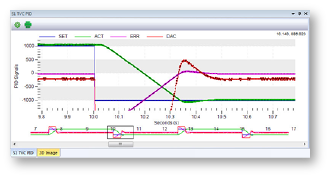 Further, Omniware developed the first and second stage FPGA based proportional-integral-derivative (PID) controllers for the thrust vector control actuators (TVCA). The first stage TVCA control was through an 1800 PSI shuttle valve with error feedback from a linear variable differential transformer (LVDT) sensor. The second stage used a brushless DC motor with acceleration and position feedback from a Harowe brushless rotary resolver and Hall Effect sensors. A third FPGA based PID controller was implemented for the first stage tail fin control also using a brushless DC motor and HALL sensors.
Further, Omniware developed the first and second stage FPGA based proportional-integral-derivative (PID) controllers for the thrust vector control actuators (TVCA). The first stage TVCA control was through an 1800 PSI shuttle valve with error feedback from a linear variable differential transformer (LVDT) sensor. The second stage used a brushless DC motor with acceleration and position feedback from a Harowe brushless rotary resolver and Hall Effect sensors. A third FPGA based PID controller was implemented for the first stage tail fin control also using a brushless DC motor and HALL sensors.
Finally, Omniware developed a real-world high-fidelity hardware and software simulation of the first stage TVCA’s hydrodynamic equations of motion using an Intel Cyclone IV FPGA, a MathWorks Simulink model running on a mini-desktop PC and interface electronics to the engine controller.
Wearable Medical Device
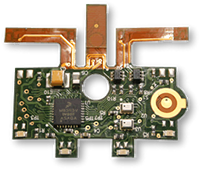 Omniware developed the embedded controller and flex circuit for a rapid prototype of a wearable
patch insulin pump. The controller was based on the KL05 Kinetis L series ultra-low power device built on the ARM Cortex-M0+ core.
Dual Bosch BMP280 digital pressure sensors were used to measure real-time atmospheric and insulin pump pressures.
A laboratory GUI application was developed for characterization and testing of the mechanical properties.
Omniware developed the embedded controller and flex circuit for a rapid prototype of a wearable
patch insulin pump. The controller was based on the KL05 Kinetis L series ultra-low power device built on the ARM Cortex-M0+ core.
Dual Bosch BMP280 digital pressure sensors were used to measure real-time atmospheric and insulin pump pressures.
A laboratory GUI application was developed for characterization and testing of the mechanical properties.
The embedded application was based on a service oriented architecture design pattern including servers and clients for handling the algorithmic delivery of insulin. A serial based communications interface was utilized for pressure acquisition and pump control during development.
Transmission X-Ray
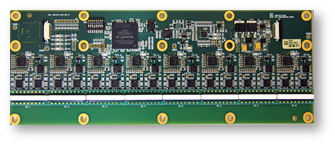 Working with Tek84 on a second generation scanner, Omniware designed the x-ray detector circuit
and printed circuit board for the new Intercept body scanner; used for high-security contraband detection. An Intel Cyclone V FPGA was used for both communications and detector signal acquisition.
Working with Tek84 on a second generation scanner, Omniware designed the x-ray detector circuit
and printed circuit board for the new Intercept body scanner; used for high-security contraband detection. An Intel Cyclone V FPGA was used for both communications and detector signal acquisition. 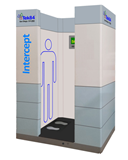 A MAC (media access controller) layer
IP (intellectual property) was developed for packet transport to Microchip’s LAN8720 PHY RMII (reduced media independent interface)
running at 100 Mbps. Each detector board used 8 Analog Device’s AD7175-8 24-Bit sigma-delta converters for a
total of 128 independent analog channels. Each channel was sampled at 50 thousand samples per second.
The MAC IP assembled UDP (user datagram protocol) packets for image transport to the user interface.
The FPGA utilized the NIOS-II embedded soft processor for communications and control.
A MAC (media access controller) layer
IP (intellectual property) was developed for packet transport to Microchip’s LAN8720 PHY RMII (reduced media independent interface)
running at 100 Mbps. Each detector board used 8 Analog Device’s AD7175-8 24-Bit sigma-delta converters for a
total of 128 independent analog channels. Each channel was sampled at 50 thousand samples per second.
The MAC IP assembled UDP (user datagram protocol) packets for image transport to the user interface.
The FPGA utilized the NIOS-II embedded soft processor for communications and control.
Omniware also developed a facial recognition windows application for matching the scanned image with the subject. The OpenCV library and the Microsoft Foundation Class was used to develop the graphical user interface.
Optical Data Link
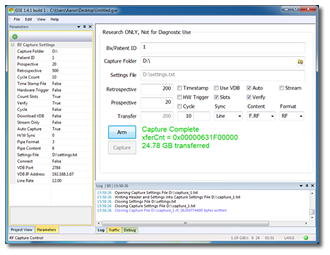 Omniware participated in a joint
effort to access high-speed beam-summed RF data from a premium performance ultrasound system in order to enable
medical research for imaging algorithm development and advanced beamforming. Utilizing commercial off-the-shelf
hardware, Omniware developed the hardware and software architectures that would
Omniware participated in a joint
effort to access high-speed beam-summed RF data from a premium performance ultrasound system in order to enable
medical research for imaging algorithm development and advanced beamforming. Utilizing commercial off-the-shelf
hardware, Omniware developed the hardware and software architectures that would 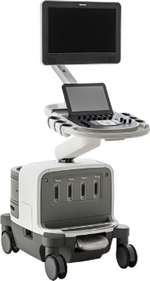 enable real-time capture and storage
of an internal bus transporting 18Gbps of RF sampled acoustic lines.
enable real-time capture and storage
of an internal bus transporting 18Gbps of RF sampled acoustic lines.
Utilizing an Altera Stratix V development kit with a QSFP+ port, a Fiberblaze PCIx8 10GBase-R capture card and a Mellanox ConnectX optical Ethernet adapter an end-to-end capture of 2.25GB/s to an HP Z440 workstation equipped with PCIx SSDs was accomplished. Omniware developed the XGMII MAC interface to the Altera 10GBase-R PHY hard IP in the Stratix V, including a 256-Bit burst-read state machine running at 156.25MHz for accessing packets in DDR3. The MAC handled bidirectional variable length UDP traffic at 40Gbps.
Additionally, Omniware developed the FPGA framework using the NIOS II soft-processor and a service oriented architecture design pattern for component interaction which extended to the workstation. A Visual Studio C/C++ MFC based windows application was also developed for access to hardware and streaming storage to SSD.
Rapid Prototyping for Electrophysiological Monitoring
Omniware developed a rapid prototype for an electrophysiological monitoring application from concept to
fruition in 10 weeks. The application utilized commercial off-the-shelf reference designs from Texas Instruments, Altera (now Intel) and Omniware.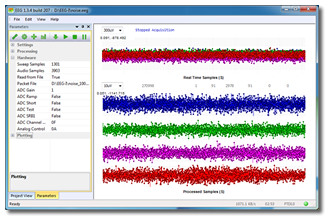
The project utilized the following items, the ADS1299, an 8-channel, simultaneously sampling 24-Bit, integrated front-end designed for an electroencephalography (EEG) application. The TLV320 is a 96 kHz stereo audio CODEC using multibit sigma-delta technology. The DE0-nano is an Altera reference design utilizing a Cyclone IV FPGA, and finally the OPTO245, a bidirectional 12Mbps data stream is optically coupled over USB to a laptop.
Omniware provided the entire design including the SPI and I2S interfaces to the analog converters, the FPGA VHDL firmware that handled careful synchronization between the data streams and the interface to the laptop. Also provided was a laboratory windows application that handled simultaneous plotting and signal processing of all eight channels in aggregate and individually. The samples were updated every 100 milliseconds, approximately a quarter-million points were plotted per second.
New Medical Ultrasound Modality
 Omniware
collaborated closely with scientists and engineers at Philips Research facility in New York on a new ultrasound imaging modality. Utilizing an
existing iU22 premium performance
ultrasound system, additional hardware and software was developed in order to image with two matrix probes simultaneously per acoustic line, frame and volume.
Omniware
collaborated closely with scientists and engineers at Philips Research facility in New York on a new ultrasound imaging modality. Utilizing an
existing iU22 premium performance
ultrasound system, additional hardware and software was developed in order to image with two matrix probes simultaneously per acoustic line, frame and volume.
Omniware was directly responsible for the software architecture, including the main control application, embedded ARM9 and NIOS II firmware, and all communication layers. A USB 3.0 implementation was also developed using the Cypress SuperSpeed FX3 controller in conjunction with an Altera Stratix IV FPGA, in order to transport real-time RF acoustic data from the iU22 to the Windows control application, where the data was decoded, time-domain processed and sent to the Medisys visualization software for volumetric imaging. Additionally, acoustic beam selection was manipulated and remotely updated on the running iU22 ultrasound hardware.
The principal investigator for the project, Emil Radulescu, Ph.D. and Sr. Scientist at Philips Research, offered these words regarding his relationship with Omniware, "I've had the pleasure to work with Omniware across multiple projects over several years. One of Omniware's strengths is to enthusiastically embark on unique, one-of-a-kind projects, and deliver outstanding turn-key solutions. Through their key contribution, Omniware translates impeccably the requirements and existing software and hardware into working prototypes and demonstrators -- they always go 'the extra mile'."
Remote Maternal Fetal Monitoring
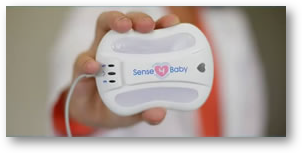 Assisting the West Health Institute in developing wireless health solutions to dramatically
lower the cost of health care, Omniware participated in West Health's first experimental medical device, a
wirelessly-enabled monitor of fetal and maternal wellness, allowing doctors to monitor mother and child remotely.
Omniware developed the firmware and hardware for communications and control of the ultrasound and tocodynamometer sensors. The product is based on two Microchip
PIC18 MCUs with nanoWatt XLP technology and a Bluetooth wireless link to an Android smartphone. One 8-Bit
MCU was dedicated to measuring both sensors while the other was responsible for heart rate audio, wireless
communications and power conservation. The device achieved 510(k) clearance November 2013.
Assisting the West Health Institute in developing wireless health solutions to dramatically
lower the cost of health care, Omniware participated in West Health's first experimental medical device, a
wirelessly-enabled monitor of fetal and maternal wellness, allowing doctors to monitor mother and child remotely.
Omniware developed the firmware and hardware for communications and control of the ultrasound and tocodynamometer sensors. The product is based on two Microchip
PIC18 MCUs with nanoWatt XLP technology and a Bluetooth wireless link to an Android smartphone. One 8-Bit
MCU was dedicated to measuring both sensors while the other was responsible for heart rate audio, wireless
communications and power conservation. The device achieved 510(k) clearance November 2013.
Additionally, a 10 week curriculum of "Hands on FPGA Development" was taught onsite to West Health engineers and scientists using Terasic's DE0-Nano Cyclone IV reference design and Altera's Quartus II FPGA development tools including Qsys, Eclipse for NIOS II, and SignalTap.
The West Health Institute's Director of Research and Development, Freeman Rose, had these words to say about his experience with Omniware, "Omniware's extensive background in signal processing, software development and physics makes them an ideal resource for developing mixed technology systems. We can highly recommend Omniware for your most challenging projects."
Nuclear Magnetic Resonance Spectroscopy
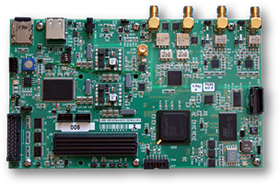 Working closely with One Resonance Sensors' chief scientist,
Omniware participated in the design of our third generation spectrometer. We were responsible for the main RF control
circuit and digital downconverter for an NMR spectroscopy application. The
circuit is built around Xilinx's 45nm low power Spartan-6 FPGA and data transport is
accomplished using Cypress' EZ-USB FX2 high-speed peripheral controller.
Working closely with One Resonance Sensors' chief scientist,
Omniware participated in the design of our third generation spectrometer. We were responsible for the main RF control
circuit and digital downconverter for an NMR spectroscopy application. The
circuit is built around Xilinx's 45nm low power Spartan-6 FPGA and data transport is
accomplished using Cypress' EZ-USB FX2 high-speed peripheral controller.
The Microblaze 32-Bit RISC CPU 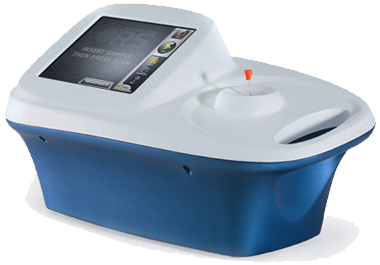 firmware was developed using Xilinx's Software
Development Kit (an Eclipse based IDE) along with
the Platform Studio to develop the VHDL code. Aldec's Active-HDL was also used for FPGA design creation and
simulation. A windows application was developed for laboratory testing and parameter tuning. The application was
written using Microsoft's Visual Studio C/C++ 2010
development environment; also incorporating the Microsoft Foundation Class (MFC) library for
the graphical user interface. In an excerpt from a recent email, Chief Scientist and Director of Systems Development,
James F. Chepin, Ph.D. had this to say, "For more than 10 years and across three companies I have relied on
Omniware’s exceptional technical knowledge and dedication on our most complex digital hardware and software
designs. Their work always exceeded our expectations in terms of commitment, proficiency, and expertise. I
wholeheartedly recommend Omniware for your most difficult technical challenges."
firmware was developed using Xilinx's Software
Development Kit (an Eclipse based IDE) along with
the Platform Studio to develop the VHDL code. Aldec's Active-HDL was also used for FPGA design creation and
simulation. A windows application was developed for laboratory testing and parameter tuning. The application was
written using Microsoft's Visual Studio C/C++ 2010
development environment; also incorporating the Microsoft Foundation Class (MFC) library for
the graphical user interface. In an excerpt from a recent email, Chief Scientist and Director of Systems Development,
James F. Chepin, Ph.D. had this to say, "For more than 10 years and across three companies I have relied on
Omniware’s exceptional technical knowledge and dedication on our most complex digital hardware and software
designs. Their work always exceeded our expectations in terms of commitment, proficiency, and expertise. I
wholeheartedly recommend Omniware for your most difficult technical challenges."
Backscatter and Transmission X-Ray
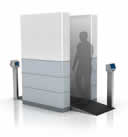 Working with Tek84 and Dr. Steven W. Smith (the foremost technical expert on
airport x-ray body scanners and inventor of the technology) Omniware designed the main data acquisition and machine
control circuit for the AIT84 Body Scanner. The circuit utilized
an Analog Devices Blackfin digital
signal processor (DSP) in unison with a Xilinx Spartan-3 Field Programmable Gate Array (FPGA).
Working with Tek84 and Dr. Steven W. Smith (the foremost technical expert on
airport x-ray body scanners and inventor of the technology) Omniware designed the main data acquisition and machine
control circuit for the AIT84 Body Scanner. The circuit utilized
an Analog Devices Blackfin digital
signal processor (DSP) in unison with a Xilinx Spartan-3 Field Programmable Gate Array (FPGA).
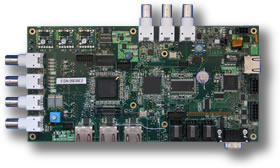 The DSP handled machine communications, command and control and data formatting. The
FPGA provided high-speed multi-channel analog-to-digital conversion and time-critical machine control including x-ray
motion and synchronization. Omniware developed the firmware for both the DSP and FPGA in addition to schematic capture
and PCB layout. The layout was done using the Mentor Graphics PADS design tools.
The DSP handled machine communications, command and control and data formatting. The
FPGA provided high-speed multi-channel analog-to-digital conversion and time-critical machine control including x-ray
motion and synchronization. Omniware developed the firmware for both the DSP and FPGA in addition to schematic capture
and PCB layout. The layout was done using the Mentor Graphics PADS design tools.
Additionally, Omniware worked on the FPGA Intellectual Property (IP) for the passenger vehicle low-dosage x-ray scanning system that was ultimately sold to SAIC (services business spin-off to Leidos). This included data acquisition for the solid-state x-ray detectors, data formatting, combining and communications.
A few words from Dr. Smith, "Omniware has completed two major projects for us, both involving the design of high performance digital electronics and associated firmware. Their knowledge of the field is exceptional and their execution rapid and confident. I would highly recommend Omniware for the most challenging projects."
Medical Device RF Generation
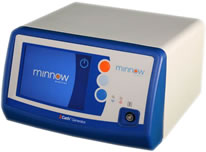 Omniware worked with Minnow Medical engineers (now Vessix Vascular, recently acquired
by Boston Scientific for $425
million) to develop the ZCath Peripheral Vascular System. A transluminal angioplasty catheter with RF electrodes that
provide controlled energy for plaque volume reduction. We developed the main digital electronics and firmware for
measuring and controlling the RF generation at the catheter tip. The circuit was built around a Xilinx Virtex-4 FPGA which contained a single PowerPC 405
embedded processor.
Omniware worked with Minnow Medical engineers (now Vessix Vascular, recently acquired
by Boston Scientific for $425
million) to develop the ZCath Peripheral Vascular System. A transluminal angioplasty catheter with RF electrodes that
provide controlled energy for plaque volume reduction. We developed the main digital electronics and firmware for
measuring and controlling the RF generation at the catheter tip. The circuit was built around a Xilinx Virtex-4 FPGA which contained a single PowerPC 405
embedded processor.
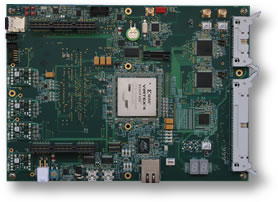 The FPGA handled the multi-channel analog-to-digital conversion, RF synthesis and
downconverter. The PowerPC managed data collection, formatting and the graphical user interface. A windows application
was written using Microsoft’s Visual Studio C/C++ to provide laboratory control, data analysis and
visualization.
The FPGA handled the multi-channel analog-to-digital conversion, RF synthesis and
downconverter. The PowerPC managed data collection, formatting and the graphical user interface. A windows application
was written using Microsoft’s Visual Studio C/C++ to provide laboratory control, data analysis and
visualization.
The product has achieved the European CE Mark and is currently pending 510(k) approval by the U.S. Food and Drug Administration for use in the United States to treat de novo lesions in the peripheral arteries and renal denervation..
The Xilinx Software Development Kit (SDK) and Platform Studio (XPS) was used to develop the VHDL code and C/C++ PowerPC firmware for the ZCath product. The PCB design flow and schematic capture used Altium's legacy software product P-CAD.
A testimonial from Minnow Medical's Chief Technical Officer Michael Perry, "Omniware’s technical service enabled Minnow Medical to produce a top quality RF generator for medical use. Given a set of high level system requirements, Omniware produced a fully functional operating product as a turnkey service with a minimum of overhead. We look forward to utilizing Omniware’s prompt services in the future."
Electromagnetic Poynting Vector
 Omniware developed a 6-channel RF data acquisition controller for Quasar Federal Systems. Working closely with Quasar’s science and
engineering team, a system architecture was created that could simultaneously sense the full electric and magnetic
field vectors from a proprietary antenna array in the LF and HF frequency ranges for the purpose of direction finding
of electromagnetic radio sources.
Omniware developed a 6-channel RF data acquisition controller for Quasar Federal Systems. Working closely with Quasar’s science and
engineering team, a system architecture was created that could simultaneously sense the full electric and magnetic
field vectors from a proprietary antenna array in the LF and HF frequency ranges for the purpose of direction finding
of electromagnetic radio sources.
The traveling EM wave is sensed by two sets of three co-located field sensors, one set for the E-Field the other
for the B-Field. Each set is mutually orthogonal and the cross product between the E-Field and B-Field may be used to
calculate the Poynting vector. The Poynting vector points
along the EM wave direction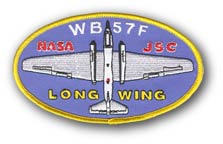 of travel, hence reversing the sign points back to the
source. Direction finding of airborne and earth-based electromagnetic sources can be done with a single
measurement.
of travel, hence reversing the sign points back to the
source. Direction finding of airborne and earth-based electromagnetic sources can be done with a single
measurement.
The design incorporated a Xilinx Virtex-5 FPGA and the Microblaze embedded soft processor. The FPGA provided simultaneous RF downconversion of six analog-to-digital converters and streamed the result to a solid-state hard drive or ethernet interface. The Microblaze CPU handled control, communications and file system management. A Windows application was written that gathered data from the embedded processor for analysis and visualization. Product brochure.
Omniware has completed many other electromagnetic sensing projects with Quasar Federal Systems over the past six years, many have flown on NASA's WB-57F Long Wing aircraft. In an excerpt from a recent email, Dr. Lowell Burnett, the President of QFS had this to say, "In our work to develop advanced sensing systems, Omniware has led some of the most demanding digital hardware and software design tasks from concept to final testing. They have never fallen short of our high expectations, even under very demanding circumstances."
Medical Ultrasound
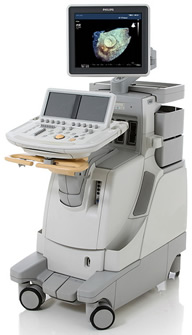 Omniware
provided multiple software modules to Philips
Research North America for controlling a per-channel data acquisition system which simultaneously sampled 128 ultrasound channels and stored the resultant 8 second
acquisition into 64 gigabytes of DDR2 memory. A direct memory access (DMA) hardware driver for compactPCI and
acquisition control user interface was written using Jungo’s WinDriver
connectivity product and Microsoft’s Visual Studio
C/C++ integrated development environment (IDE). Two-dimensional imaging and RF data visualization was also
provided. Omniware worked closely with Philips engineers during final integration assisting in hardware and software
debugging. The product was delivered to research staff where it is currently being used for photoacoustic tomography, adaptive imaging, high-intensity focused ultrasound, molecular imaging and elastography.
Omniware
provided multiple software modules to Philips
Research North America for controlling a per-channel data acquisition system which simultaneously sampled 128 ultrasound channels and stored the resultant 8 second
acquisition into 64 gigabytes of DDR2 memory. A direct memory access (DMA) hardware driver for compactPCI and
acquisition control user interface was written using Jungo’s WinDriver
connectivity product and Microsoft’s Visual Studio
C/C++ integrated development environment (IDE). Two-dimensional imaging and RF data visualization was also
provided. Omniware worked closely with Philips engineers during final integration assisting in hardware and software
debugging. The product was delivered to research staff where it is currently being used for photoacoustic tomography, adaptive imaging, high-intensity focused ultrasound, molecular imaging and elastography.
Additionally, Omniware provided software enhancements to the original acquisition product in order to stream
the Ultrasound RF channels through dual 1 gigabit Ethernet interfaces by incorporating Pleora Technology’s iPort video
transmitter software; each channel achieved nearly 95 megabytes per second of data throughput.
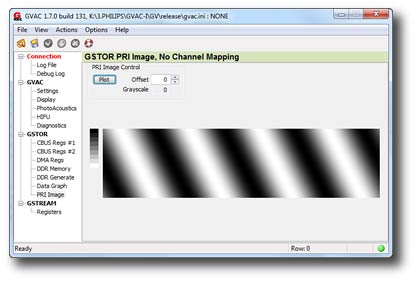 John Dean, Senior
Member Research Staff: Prototyping Group of Philips Research North America, wrote the following about his experience
with our company, “Omniware not only was able to deliver the software we needed, but in addition improved
our software drivers, helped isolate difficult to detect hardware problems, made suggestions to improve the hardware
architecture, and even worked with our engineers to solve problems with power distribution. In summary, Omniware
delivered beyond the scope of the original task and was instrumental in helping us deliver a quality system to our
customer.”
John Dean, Senior
Member Research Staff: Prototyping Group of Philips Research North America, wrote the following about his experience
with our company, “Omniware not only was able to deliver the software we needed, but in addition improved
our software drivers, helped isolate difficult to detect hardware problems, made suggestions to improve the hardware
architecture, and even worked with our engineers to solve problems with power distribution. In summary, Omniware
delivered beyond the scope of the original task and was instrumental in helping us deliver a quality system to our
customer.”
Over the past three decades Omniware has been involved in many hardware and software design projects in the
medical ultrasound industry with companies such as Philips Ultrasound, Acoustic Imaging, CooperVision and Alliance
Medical. We participated in several Ultrasound related U.S. patents, namely:
- “Ultrasound Apparatus for Three-Dimensional Image Reconstruction”
- “Method and Ultrasound Apparatus for Fast Acquisition of Two-Dimensional Images”
- “Method and Apparatus for Fast Acquisition of Ultrasound Images”
- “Ultrasound Transducers for Real Time Two and Three Dimensional Image Acquisition”
Nuclear Quadrupole Resonance (NQR) Spectroscopy
 Omniware
developed two generations of NQR spectrometers
for Quantum Magnetics (a wholly-owned subsidiary of Morpho
Detection). The first generation was proof-of-concept for a portable land-mine detector and used Motorola’s
(now freescale's) DSP56K and a
Xilinx Spartan-II FPGA. Omniware developed the data acquisition hardware, firmware and Windows software application
for control and data visualization. The Spartan-II handled the CPMG NQR pulse sequences and other RF
timing. The DSP56K dealt with command and control, communications, and data formatting. The spectrometer successfully
detected TNT, PETN and RDX explosives at the Yuma Proving
Grounds in Arizona.
Omniware
developed two generations of NQR spectrometers
for Quantum Magnetics (a wholly-owned subsidiary of Morpho
Detection). The first generation was proof-of-concept for a portable land-mine detector and used Motorola’s
(now freescale's) DSP56K and a
Xilinx Spartan-II FPGA. Omniware developed the data acquisition hardware, firmware and Windows software application
for control and data visualization. The Spartan-II handled the CPMG NQR pulse sequences and other RF
timing. The DSP56K dealt with command and control, communications, and data formatting. The spectrometer successfully
detected TNT, PETN and RDX explosives at the Yuma Proving
Grounds in Arizona.
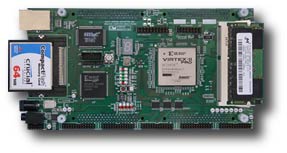 The second generation
NQR spectrometer utilized a single Xilinx Virtex-II Pro FPGA with dual embedded PowerPC 405s. Two variations on time-critical operating systems
were ported to the PowerPC 405, namely, Micrium’s uC/OS-II and QNX Software System’s Neutrino RTOS.
This implementation used high-speed ADCs and a digital downconverter for data acquisition. In addition to NQR
spectroscopy the hardware also implemented advanced metal detection. The base hardware was ultimately used in
Morpho's implementation of the shoe scanner.
The second generation
NQR spectrometer utilized a single Xilinx Virtex-II Pro FPGA with dual embedded PowerPC 405s. Two variations on time-critical operating systems
were ported to the PowerPC 405, namely, Micrium’s uC/OS-II and QNX Software System’s Neutrino RTOS.
This implementation used high-speed ADCs and a digital downconverter for data acquisition. In addition to NQR
spectroscopy the hardware also implemented advanced metal detection. The base hardware was ultimately used in
Morpho's implementation of the shoe scanner.
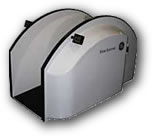 Director of Advanced Development at Quantum Magnetics, Pablo
Prado, Ph.D. had this to say, “Omniware was a vital contributor during the Advanced Mine Detector project
with the Office of Naval Research. They led software and firmware
development tasks and contributed to the design and testing of a process intensive FPGA-based radio-frequency
control board. Omniware's high quality deliverables enabled the engineering team to produce a state-of-the-art
instrument which demonstrated high detection performance.”
Director of Advanced Development at Quantum Magnetics, Pablo
Prado, Ph.D. had this to say, “Omniware was a vital contributor during the Advanced Mine Detector project
with the Office of Naval Research. They led software and firmware
development tasks and contributed to the design and testing of a process intensive FPGA-based radio-frequency
control board. Omniware's high quality deliverables enabled the engineering team to produce a state-of-the-art
instrument which demonstrated high detection performance.”
Communications
 Omniware worked with Nokia Mobile
Phone engineers as principal architect and lead developer for a CDMA High-Speed Packet Data design and
implementation (IS-707.5,12) using TI's TMS470 microcontroller,
TMS320C54 DSP and Nokia's proprietary real-time operating system.
Furthermore, Omniware developed a software object model for managing data bearer services with multiple contexts.
Omniware worked with Nokia Mobile
Phone engineers as principal architect and lead developer for a CDMA High-Speed Packet Data design and
implementation (IS-707.5,12) using TI's TMS470 microcontroller,
TMS320C54 DSP and Nokia's proprietary real-time operating system.
Furthermore, Omniware developed a software object model for managing data bearer services with multiple contexts.
 At Motorola’s Satellite division in Chandler
Arizona, Omniware provided advanced development and rapid prototyping of the L-Band Physical Layer for the Iridium Satellite Vehicle PowerPC 603e Antenna Computer, using Greenhills C/C++ compiler and pSOS
embedded real-time operating system with a development environment hosted by Sun Microsystems SunOS (UNIX). Also, we implemented a Power-On Self Test (POST) software
module for the Antenna Computer while on orbit to detect and correct single event upsets and provide confidence testing of
communications hardware. Computed beam-to-beam distance tables of earth surface illumination for overlap and
interference control, and the software module for one-time pad
calculations and command & control encryption.
At Motorola’s Satellite division in Chandler
Arizona, Omniware provided advanced development and rapid prototyping of the L-Band Physical Layer for the Iridium Satellite Vehicle PowerPC 603e Antenna Computer, using Greenhills C/C++ compiler and pSOS
embedded real-time operating system with a development environment hosted by Sun Microsystems SunOS (UNIX). Also, we implemented a Power-On Self Test (POST) software
module for the Antenna Computer while on orbit to detect and correct single event upsets and provide confidence testing of
communications hardware. Computed beam-to-beam distance tables of earth surface illumination for overlap and
interference control, and the software module for one-time pad
calculations and command & control encryption.
Additionally, Omniware developed an OPNET model to simulate hand-off between the satellite vehicle and subscriber unit. The model involved orbital parameters of the satellite, differential Doppler and time-of-arrival computations, profile of phased-array beam and kalman filter tracking of the satellite vehicle.
Superconducting Magnets
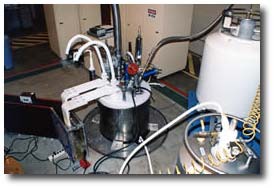 Omniware led a team of scientists, engineers and technicians in the creation and operation of
two premiere cold test facilities for superconducting
accelerator magnet and cable research. The facilities were constructed under the auspices of the Department of Energy at the Superconducting Supercollider Laboratory in
Texas. The facilities were used to test model superconducting magnets at temperature and current of the full collider
ring. Ultimately 18 one meter model dipole and quadrupole superconducting magnets were tested along with wire strands
and cable. Each test facility was situated in a high-bay with overhead crane access and consisted of a 2K liter helium cryostat, 15K ampere power supply, data acquisition and storage, and
control instrumentation. Magnets were cooled to a temperature of 4.2K with liquid helium and energized with 10-15K amperes of current to
determine the mechanical strain due to Lorentz forces, the quench properties and magnet field
homogeneity.
Omniware led a team of scientists, engineers and technicians in the creation and operation of
two premiere cold test facilities for superconducting
accelerator magnet and cable research. The facilities were constructed under the auspices of the Department of Energy at the Superconducting Supercollider Laboratory in
Texas. The facilities were used to test model superconducting magnets at temperature and current of the full collider
ring. Ultimately 18 one meter model dipole and quadrupole superconducting magnets were tested along with wire strands
and cable. Each test facility was situated in a high-bay with overhead crane access and consisted of a 2K liter helium cryostat, 15K ampere power supply, data acquisition and storage, and
control instrumentation. Magnets were cooled to a temperature of 4.2K with liquid helium and energized with 10-15K amperes of current to
determine the mechanical strain due to Lorentz forces, the quench properties and magnet field
homogeneity.
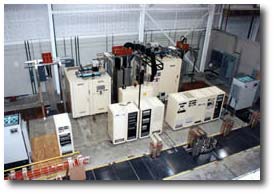 Utilizing Sun Microsystems
workstations and VME based SPARC embedded controllers in a distributed processor architecture of
high-speed data collection and real-time analysis the facility was able to acquire critical magnet data used by
scientists and engineers to characterize the performance of new accelerator magnet designs. Data was made available to
laboratory personnel and magnet vendors using the relational database Sybase SQL Server.
Utilizing Sun Microsystems
workstations and VME based SPARC embedded controllers in a distributed processor architecture of
high-speed data collection and real-time analysis the facility was able to acquire critical magnet data used by
scientists and engineers to characterize the performance of new accelerator magnet designs. Data was made available to
laboratory personnel and magnet vendors using the relational database Sybase SQL Server.
Here are a few selected papers relating to this facility from the fifth anual Proceedings of the International Symposium on the Super Collider:
- "Cold Test Facility for 1.8 M Superconducting Model Magnets at the SSCL"
- "Test Perfomance of the QSE Series of 5 cm Aperture Quadrapole Model Magnets"
- "An Ordinary Method of Cutting a Stainless Steel Beem Tube Inside the Superconducting Dipole Magnet without Disassembly"
The president of EG&G Science Support Corporation had this to say about Omniware, “… they successfully brought to fruition a comprehensive, well-performing test facility. In accomplishing this goal, Omniware put in effort above and beyond that expected.” Also, the SSCL Quadrupole Magnet Product Manager, Dave Fortunato wrote these words, “Omniware’s broad background in signal processing, software development and physics made them an ideal choice for developing systems with complex physical interactions.”
